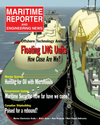
Page 4: of Maritime Reporter Magazine (April 2005)
The Offshore Industry Anual
Read this page in Pdf, Flash or Html5 edition of April 2005 Maritime Reporter Magazine
A powerful, high-precision multibeam echosounder system, jointly developed by the U.S. Navy and SeaBeam Instruments, Inc. over a decade ago, provided the world with its first images of the ocean floor near the epicenter of the Asian tsunami. The SASS IV system installed aboard the UK Navy's oceanographic survey vessel, HMS
Scott, is a low-frequency, high resolu- tion sonar system that collects and processes seafloor depth data, over a wide swath, in near real-time.
Following the 9.0 magnitude quake that occurred on December 26, 2004 the Scott deployed to the area and quickly collected a significant amount of bathymetric data. The data was then used to create 3-D images that scientists are still evaluating to further their understand- ing of the earthquake and assist in the prediction of such events in the future. The SASS seafloor images, recently released by the UK
Ministry of Defense (MOD), show enormous "scars" more than 6 miles wide and newly formed ridges up to 1,500 meters (4,950 feet) high that were thrust up when the India tectonic plate collided with and pushed underneath the Burma plate. The SASS
IV is a unique ocean mapping system used by both the U.S. and U.K. Navies to survey deep- ocean areas around the globe. SeaBeam
Instruments, Inc. was contracted by the Navy to design and deliver major components of the
SASS systems in the 1980's and 1990's. In 1999, SeaBeam Instruments, Inc. was acquired by L-3 Communications and is cur- rently a product division of L-3
Communications Klein Associates of Salem,
NH. The company continues to spearhead the evolution of multibeam technology and has recently introduced its latest generation com- mercial multibeam system, the SEA BEAM 3000, which allows users the same ability to create accurate high resolution maps of the seafloor at all depths and in near real-time.
Leading Off 4 Maritime Reporter & Engineering News
Circle 270 on Reader Service Card
Maritime Meanings
Crackerjack A sea dish consisting of preserved meat or soup, mixed with broken ship's biscuit and other ingredients; other dishes well- known to the seafarer were "burgoo" (boiled oatmeal porridge seasoned with salt, sugar, and butter, and said to derive from the Vikings); "dandyfunk" (broken ship's biscuit and molasses); "lobscouse" (a stew consisting of salt meat, potatoes, broken ship's biscuit, onions, and available spices); and "sea pie" (a favorite, consisting of meat and vegetables layered between crusts of pastry).
The generic word for these odds and ends of food leftovers was manavlins, of unknown origin and variously spelled. From its earliest nauti- cal meaning of tidbits of food, it came to mean small matters, extra fresh food belonging to whale-fishers, any small object, and the odd change remaining at the end of the day in the railway booking office (recorded 1887). The word is used in its earliest sense by Rolf
Boldrewood in his Australian classic Robber Under Arms (1888). The colloquial meaning has changed considerably. Crackerjack (sometimes written "crackajack") now refers to a person of marked ability, or something exceptionally fine, or to some event of note.
Source: An Ocean of Words: A Dictionary of Nautical Words and Phrases, by Peter D. Jeans; Birch Lane Press , 1999
On sea trials in Chesapeake Bay, 1964.
The Navy plans to send one of its own - the retired air- craft carrier USS America - to the bottom of the ocean in a series of explosion tests which are designed to provide invaluable data for the construction and out- fitting of the next generation of aircraft carriers, the
Associated Press reported. The Navy will spend $22 million on tests that will span several weeks, starting with a tow approximately 300 miles off of the east coast, and ending with its sinking in approximately 6,000 feet of water. The tests that will be closed to the press and the public's eyes. USS America was commissioned in 1965, decommissioned in 1996, and has spent the last nine years moored with other inactive warships at a Navy yard in Philadelphia.
Taking One for the Team
First Seafloor Maps of Tsunami Earthquake Zone
MR APRIL 2005 #1 (1-8).qxd 4/1/2005 1:40 PM Page 6

 3
3

 5
5
